Henk Corporaal
Sparse Convolutional Recurrent Learning for Efficient Event-based Neuromorphic Object Detection
Jun 16, 2025Abstract:Leveraging the high temporal resolution and dynamic range, object detection with event cameras can enhance the performance and safety of automotive and robotics applications in real-world scenarios. However, processing sparse event data requires compute-intensive convolutional recurrent units, complicating their integration into resource-constrained edge applications. Here, we propose the Sparse Event-based Efficient Detector (SEED) for efficient event-based object detection on neuromorphic processors. We introduce sparse convolutional recurrent learning, which achieves over 92% activation sparsity in recurrent processing, vastly reducing the cost for spatiotemporal reasoning on sparse event data. We validated our method on Prophesee's 1 Mpx and Gen1 event-based object detection datasets. Notably, SEED sets a new benchmark in computational efficiency for event-based object detection which requires long-term temporal learning. Compared to state-of-the-art methods, SEED significantly reduces synaptic operations while delivering higher or same-level mAP. Our hardware simulations showcase the critical role of SEED's hardware-aware design in achieving energy-efficient and low-latency neuromorphic processing.
STEM: Spatial-Temporal Mapping Tool For Spiking Neural Networks
Feb 05, 2025



Abstract:Spiking Neural Networks (SNNs) are promising bio-inspired third-generation neural networks. Recent research has trained deep SNN models with accuracy on par with Artificial Neural Networks (ANNs). Although the event-driven and sparse nature of SNNs show potential for more energy efficient computation than ANNs, SNN neurons have internal states which evolve over time. Keeping track of SNN states can significantly increase data movement and storage requirements, potentially losing its advantages with respect to ANNs. This paper investigates the energy effects of having neuron states, and how it is influenced by the chosen mapping to realistic hardware architectures with advanced memory hierarchies. Therefore, we develop STEMS, a mapping design space exploration tool for SNNs. STEMS models SNN's stateful behavior and explores intra-layer and inter-layer mapping optimizations to minimize data movement, considering both spatial and temporal SNN dimensions. Using STEMS, we show up to 12x reduction in off-chip data movement and 5x reduction in energy (on top of intra-layer optimizations), on two event-based vision SNN benchmarks. Finally, neuron states may not be needed for all SNN layers. By optimizing neuron states for one of our benchmarks, we show 20x reduction in neuron states and 1.4x better performance without accuracy loss.
Probabilistic Inference in the Era of Tensor Networks and Differential Programming
May 22, 2024



Abstract:Probabilistic inference is a fundamental task in modern machine learning. Recent advances in tensor network (TN) contraction algorithms have enabled the development of better exact inference methods. However, many common inference tasks in probabilistic graphical models (PGMs) still lack corresponding TN-based adaptations. In this work, we advance the connection between PGMs and TNs by formulating and implementing tensor-based solutions for the following inference tasks: (i) computing the partition function, (ii) computing the marginal probability of sets of variables in the model, (iii) determining the most likely assignment to a set of variables, and (iv) the same as (iii) but after having marginalized a different set of variables. We also present a generalized method for generating samples from a learned probability distribution. Our work is motivated by recent technical advances in the fields of quantum circuit simulation, quantum many-body physics, and statistical physics. Through an experimental evaluation, we demonstrate that the integration of these quantum technologies with a series of algorithms introduced in this study significantly improves the effectiveness of existing methods for solving probabilistic inference tasks.
BOMP-NAS: Bayesian Optimization Mixed Precision NAS
Jan 27, 2023Abstract:Bayesian Optimization Mixed-Precision Neural Architecture Search (BOMP-NAS) is an approach to quantization-aware neural architecture search (QA-NAS) that leverages both Bayesian optimization (BO) and mixed-precision quantization (MP) to efficiently search for compact, high performance deep neural networks. The results show that integrating quantization-aware fine-tuning (QAFT) into the NAS loop is a necessary step to find networks that perform well under low-precision quantization: integrating it allows a model size reduction of nearly 50\% on the CIFAR-10 dataset. BOMP-NAS is able to find neural networks that achieve state of the art performance at much lower design costs. This study shows that BOMP-NAS can find these neural networks at a 6x shorter search time compared to the closest related work.
THOR -- A Neuromorphic Processor with 7.29G TSOP$^2$/mm$^2$Js Energy-Throughput Efficiency
Dec 03, 2022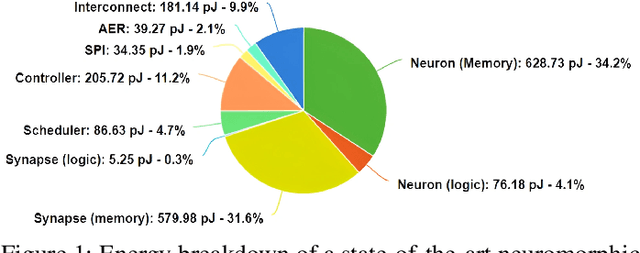
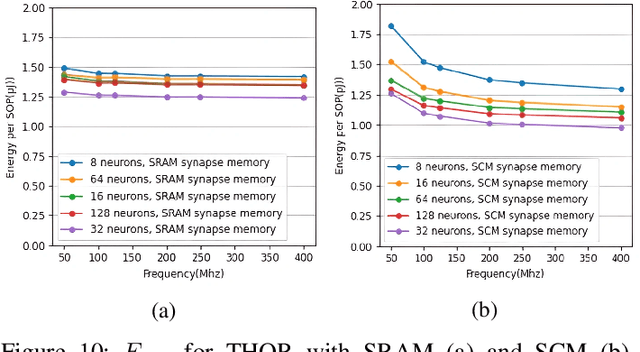
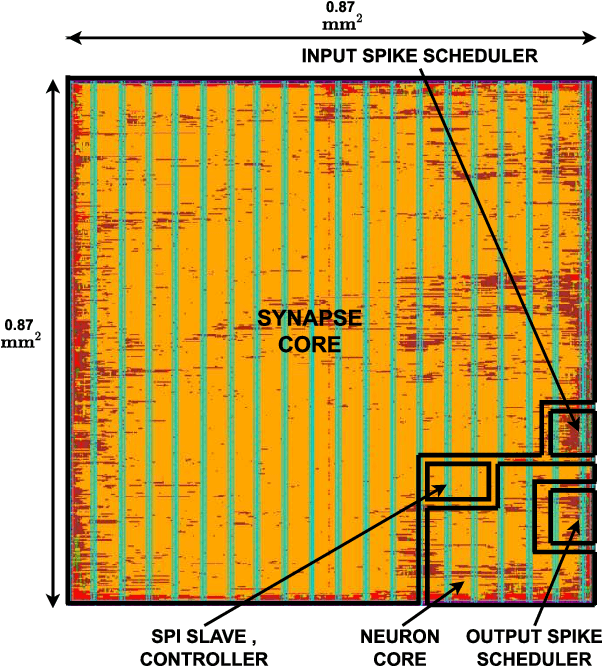
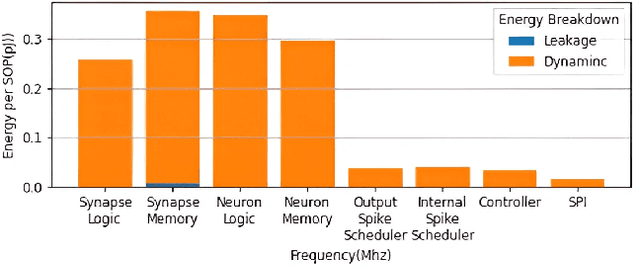
Abstract:Neuromorphic computing using biologically inspired Spiking Neural Networks (SNNs) is a promising solution to meet Energy-Throughput (ET) efficiency needed for edge computing devices. Neuromorphic hardware architectures that emulate SNNs in analog/mixed-signal domains have been proposed to achieve order-of-magnitude higher energy efficiency than all-digital architectures, however at the expense of limited scalability, susceptibility to noise, complex verification, and poor flexibility. On the other hand, state-of-the-art digital neuromorphic architectures focus either on achieving high energy efficiency (Joules/synaptic operation (SOP)) or throughput efficiency (SOPs/second/area), resulting in poor ET efficiency. In this work, we present THOR, an all-digital neuromorphic processor with a novel memory hierarchy and neuron update architecture that addresses both energy consumption and throughput bottlenecks. We implemented THOR in 28nm FDSOI CMOS technology and our post-layout results demonstrate an ET efficiency of 7.29G $\text{TSOP}^2/\text{mm}^2\text{Js}$ at 0.9V, 400 MHz, which represents a 3X improvement over state-of-the-art digital neuromorphic processors.
LEAPER: Modeling Cloud FPGA-based Systems via Transfer Learning
Aug 22, 2022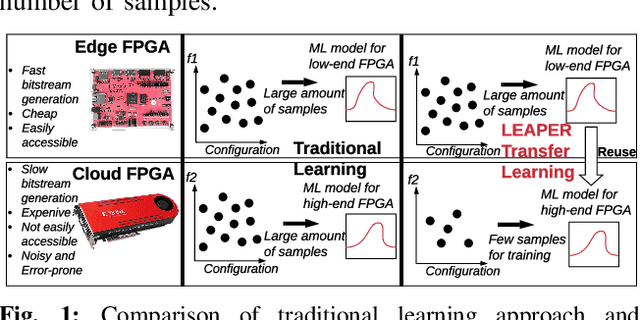
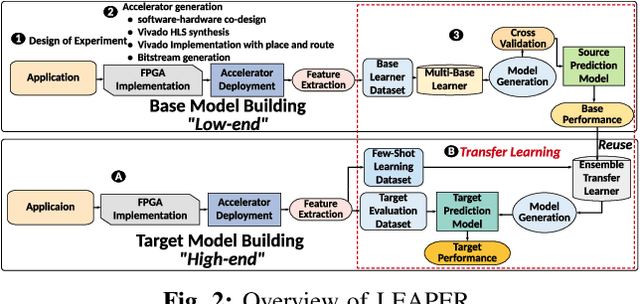

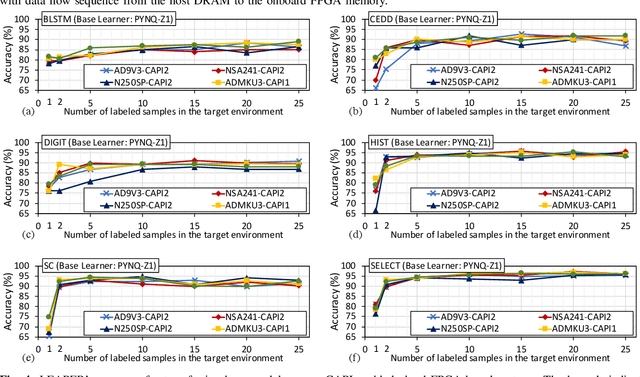
Abstract:Machine-learning-based models have recently gained traction as a way to overcome the slow downstream implementation process of FPGAs by building models that provide fast and accurate performance predictions. However, these models suffer from two main limitations: (1) training requires large amounts of data (features extracted from FPGA synthesis and implementation reports), which is cost-inefficient because of the time-consuming FPGA design cycle; (2) a model trained for a specific environment cannot predict for a new, unknown environment. In a cloud system, where getting access to platforms is typically costly, data collection for ML models can significantly increase the total cost-ownership (TCO) of a system. To overcome these limitations, we propose LEAPER, a transfer learning-based approach for FPGA-based systems that adapts an existing ML-based model to a new, unknown environment to provide fast and accurate performance and resource utilization predictions. Experimental results show that our approach delivers, on average, 85% accuracy when we use our transferred model for prediction in a cloud environment with 5-shot learning and reduces design-space exploration time by 10x, from days to only a few hours.
How to train accurate BNNs for embedded systems?
Jun 24, 2022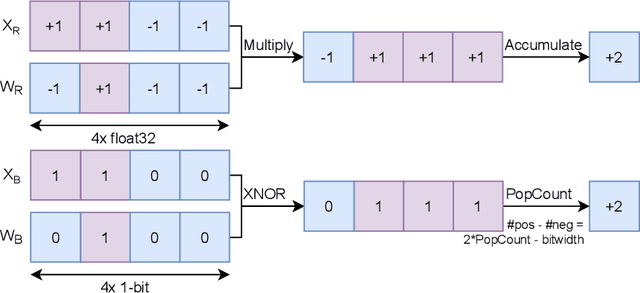
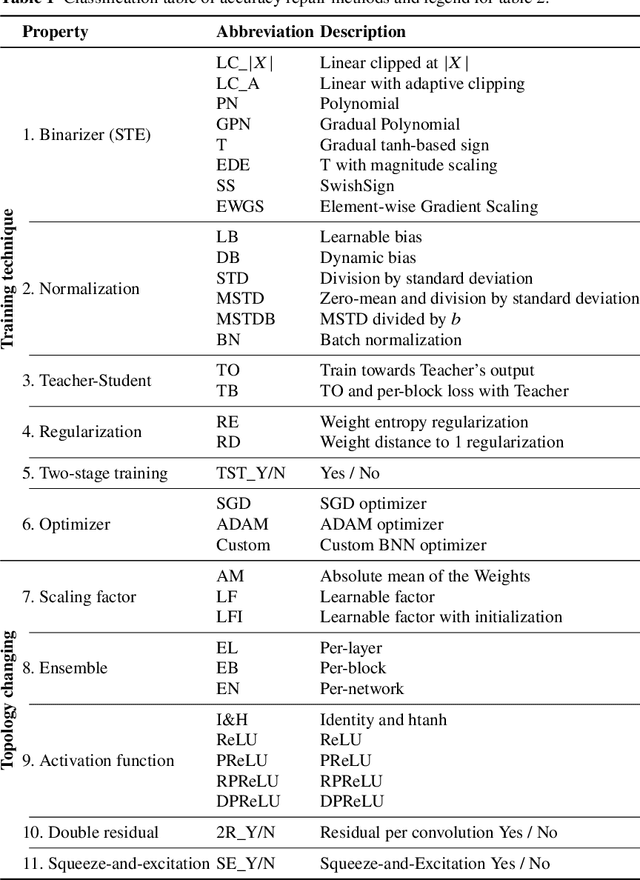
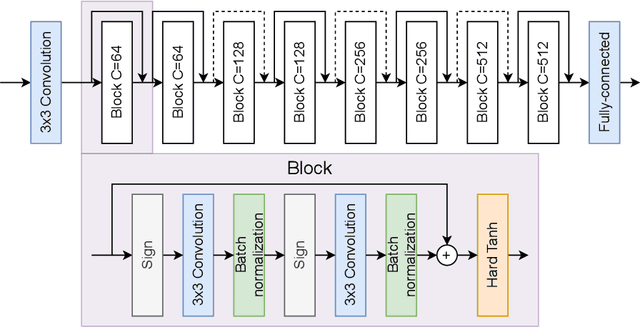
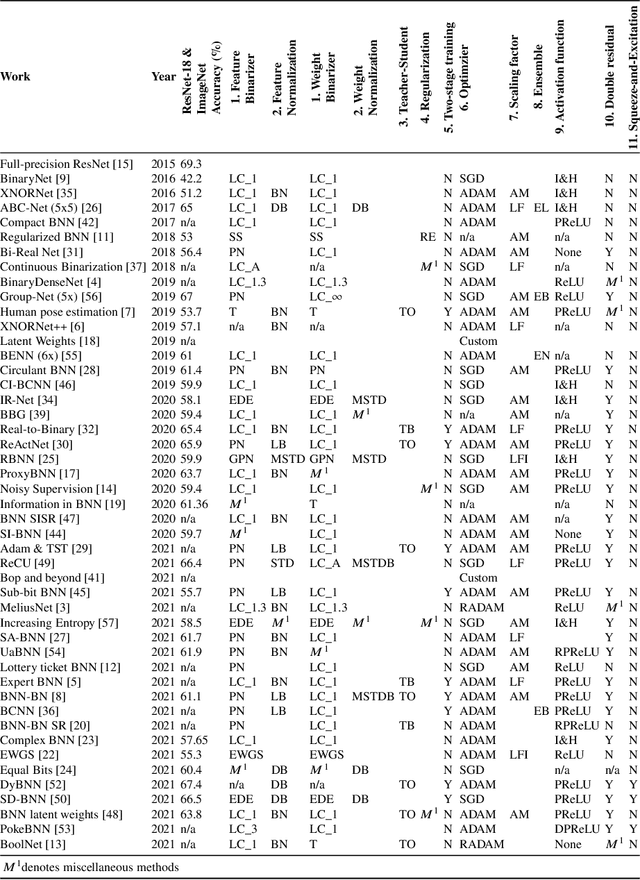
Abstract:A key enabler of deploying convolutional neural networks on resource-constrained embedded systems is the binary neural network (BNN). BNNs save on memory and simplify computation by binarizing both features and weights. Unfortunately, binarization is inevitably accompanied by a severe decrease in accuracy. To reduce the accuracy gap between binary and full-precision networks, many repair methods have been proposed in the recent past, which we have classified and put into a single overview in this chapter. The repair methods are divided into two main branches, training techniques and network topology changes, which can further be split into smaller categories. The latter category introduces additional cost (energy consumption or additional area) for an embedded system, while the former does not. From our overview, we observe that progress has been made in reducing the accuracy gap, but BNN papers are not aligned on what repair methods should be used to get highly accurate BNNs. Therefore, this chapter contains an empirical review that evaluates the benefits of many repair methods in isolation over the ResNet-20\&CIFAR10 and ResNet-18\&CIFAR100 benchmarks. We found three repair categories most beneficial: feature binarizer, feature normalization, and double residual. Based on this review we discuss future directions and research opportunities. We sketch the benefit and costs associated with BNNs on embedded systems because it remains to be seen whether BNNs will be able to close the accuracy gap while staying highly energy-efficient on resource-constrained embedded systems.
Sibyl: Adaptive and Extensible Data Placement in Hybrid Storage Systems Using Online Reinforcement Learning
May 15, 2022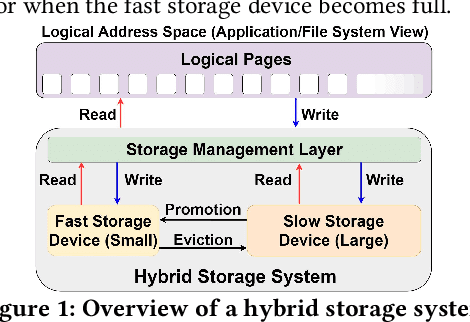

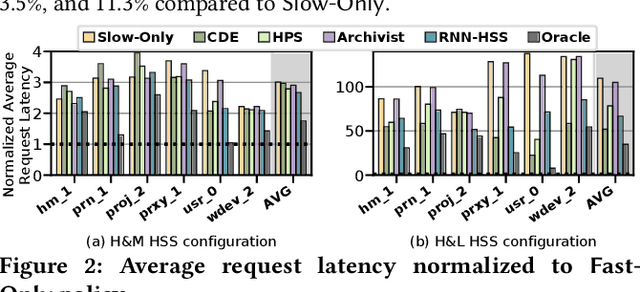

Abstract:Hybrid storage systems (HSS) use multiple different storage devices to provide high and scalable storage capacity at high performance. Recent research proposes various techniques that aim to accurately identify performance-critical data to place it in a "best-fit" storage device. Unfortunately, most of these techniques are rigid, which (1) limits their adaptivity to perform well for a wide range of workloads and storage device configurations, and (2) makes it difficult for designers to extend these techniques to different storage system configurations (e.g., with a different number or different types of storage devices) than the configuration they are designed for. We introduce Sibyl, the first technique that uses reinforcement learning for data placement in hybrid storage systems. Sibyl observes different features of the running workload as well as the storage devices to make system-aware data placement decisions. For every decision it makes, Sibyl receives a reward from the system that it uses to evaluate the long-term performance impact of its decision and continuously optimizes its data placement policy online. We implement Sibyl on real systems with various HSS configurations. Our results show that Sibyl provides 21.6%/19.9% performance improvement in a performance-oriented/cost-oriented HSS configuration compared to the best previous data placement technique. Our evaluation using an HSS configuration with three different storage devices shows that Sibyl outperforms the state-of-the-art data placement policy by 23.9%-48.2%, while significantly reducing the system architect's burden in designing a data placement mechanism that can simultaneously incorporate three storage devices. We show that Sibyl achieves 80% of the performance of an oracle policy that has complete knowledge of future access patterns while incurring a very modest storage overhead of only 124.4 KiB.
Quantization of Deep Neural Networks for Accumulator-constrained Processors
Apr 24, 2020
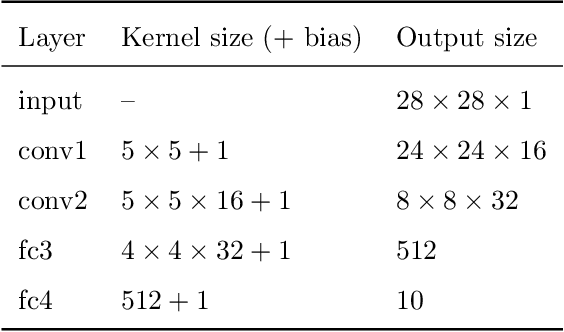
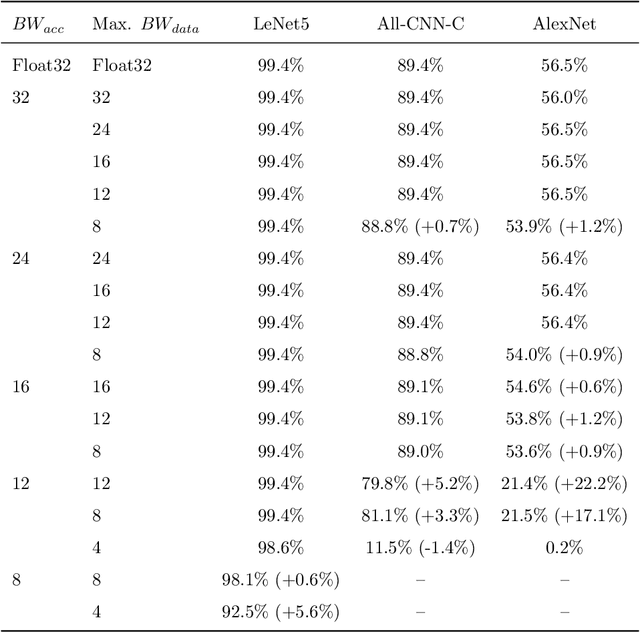
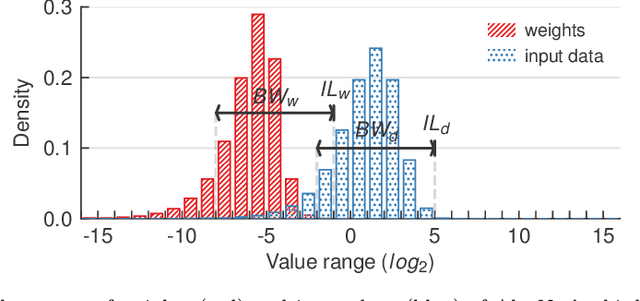
Abstract:We introduce an Artificial Neural Network (ANN) quantization methodology for platforms without wide accumulation registers. This enables fixed-point model deployment on embedded compute platforms that are not specifically designed for large kernel computations (i.e. accumulator-constrained processors). We formulate the quantization problem as a function of accumulator size, and aim to maximize the model accuracy by maximizing bit width of input data and weights. To reduce the number of configurations to consider, only solutions that fully utilize the available accumulator bits are being tested. We demonstrate that 16-bit accumulators are able to obtain a classification accuracy within 1\% of the floating-point baselines on the CIFAR-10 and ILSVRC2012 image classification benchmarks. Additionally, a near-optimal $2\times$ speedup is obtained on an ARM processor, by exploiting 16-bit accumulators for image classification on the All-CNN-C and AlexNet networks.
* 20 pages, 13 figures
LocalNorm: Robust Image Classification through Dynamically Regularized Normalization
Mar 04, 2019
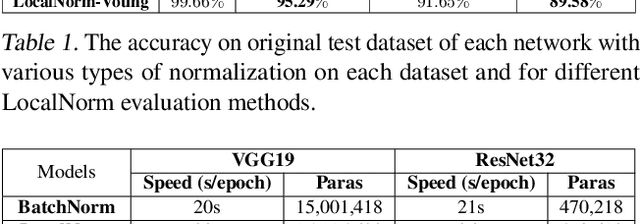


Abstract:While modern convolutional neural networks achieve outstanding accuracy on many image classification tasks, they are, compared to humans, much more sensitive to image degradation. Here, we describe a variant of Batch Normalization, LocalNorm, that regularizes the normalization layer in the spirit of Dropout while dynamically adapting to the local image intensity and contrast at test-time. We show that the resulting deep neural networks are much more resistant to noise-induced image degradation, improving accuracy by up to three times, while achieving the same or slightly better accuracy on non-degraded classical benchmarks. In computational terms, LocalNorm adds negligible training cost and little or no cost at inference time, and can be applied to already-trained networks in a straightforward manner.
 Add to Chrome
Add to Chrome Add to Firefox
Add to Firefox Add to Edge
Add to Edge